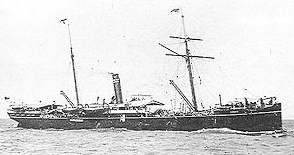SS Camorta
SS Camorta was a British steamship that sank on 6 May 1902 in the Irrawaddy Delta, Burma (now Myanmar), resulting in the loss of all 739 passengers and crew aboard. It is one of the deadliest maritime disasters in history that received little attention worldwide. The SS Camorta was owned by the British India Steam Navigation Company and was used primarily for transporting people and goods between India and Burma.
Background[edit | edit source]
The SS Camorta was built in 1880 by William Denny and Brothers in Dumbarton, Scotland. The ship was 1,846 gross tons and was powered by a single screw steam engine. It was designed for the coastal and river services in the British Empire's eastern colonies, particularly between the ports of Calcutta (now Kolkata) and Rangoon (now Yangon), and within the Irrawaddy Delta.
The Disaster[edit | edit source]
On its final voyage, the SS Camorta left Calcutta for Rangoon, carrying a mix of passengers and cargo. As it navigated through the Irrawaddy Delta, the ship encountered a severe cyclone. Despite efforts to manage the vessel in the extreme weather, the SS Camorta was overwhelmed by the storm's force, capsized, and sank.
The tragedy of the SS Camorta was compounded by the fact that there were no survivors, making it difficult to ascertain the exact circumstances leading up to the sinking. The ship's loss highlighted the dangers of maritime travel in the region, particularly during the cyclone season, and led to calls for improved weather forecasting and safety measures for ships operating in the Bay of Bengal and the Andaman Sea.
Aftermath[edit | edit source]
The sinking of the SS Camorta prompted an inquiry by the British authorities, who sought to understand the disaster's causes and to prevent similar incidents in the future. However, given the lack of survivors and the limited technology of the time, the inquiry could not conclusively determine the reasons for the ship's sinking.
The disaster had a significant impact on the British India Steam Navigation Company, leading to changes in the design and operation of their vessels. It also contributed to the development of early weather forecasting systems in the region, as the British Empire sought to protect its maritime interests.
Legacy[edit | edit source]
The SS Camorta remains one of the deadliest peacetime maritime disasters in history. It serves as a reminder of the risks faced by early maritime travelers and the importance of advancements in ship design, safety, and weather forecasting. The disaster is commemorated in maritime history books and is part of the collective memory of the communities in India and Burma affected by the tragedy.
Search WikiMD
Ad.Tired of being Overweight? Try W8MD's physician weight loss program.
Semaglutide (Ozempic / Wegovy and Tirzepatide (Mounjaro / Zepbound) available.
Advertise on WikiMD
|
WikiMD's Wellness Encyclopedia |
| Let Food Be Thy Medicine Medicine Thy Food - Hippocrates |
Translate this page: - East Asian
中文,
日本,
한국어,
South Asian
हिन्दी,
தமிழ்,
తెలుగు,
Urdu,
ಕನ್ನಡ,
Southeast Asian
Indonesian,
Vietnamese,
Thai,
မြန်မာဘာသာ,
বাংলা
European
español,
Deutsch,
français,
Greek,
português do Brasil,
polski,
română,
русский,
Nederlands,
norsk,
svenska,
suomi,
Italian
Middle Eastern & African
عربى,
Turkish,
Persian,
Hebrew,
Afrikaans,
isiZulu,
Kiswahili,
Other
Bulgarian,
Hungarian,
Czech,
Swedish,
മലയാളം,
मराठी,
ਪੰਜਾਬੀ,
ગુજરાતી,
Portuguese,
Ukrainian
Medical Disclaimer: WikiMD is not a substitute for professional medical advice. The information on WikiMD is provided as an information resource only, may be incorrect, outdated or misleading, and is not to be used or relied on for any diagnostic or treatment purposes. Please consult your health care provider before making any healthcare decisions or for guidance about a specific medical condition. WikiMD expressly disclaims responsibility, and shall have no liability, for any damages, loss, injury, or liability whatsoever suffered as a result of your reliance on the information contained in this site. By visiting this site you agree to the foregoing terms and conditions, which may from time to time be changed or supplemented by WikiMD. If you do not agree to the foregoing terms and conditions, you should not enter or use this site. See full disclaimer.
Credits:Most images are courtesy of Wikimedia commons, and templates, categories Wikipedia, licensed under CC BY SA or similar.
Contributors: Prab R. Tumpati, MD


